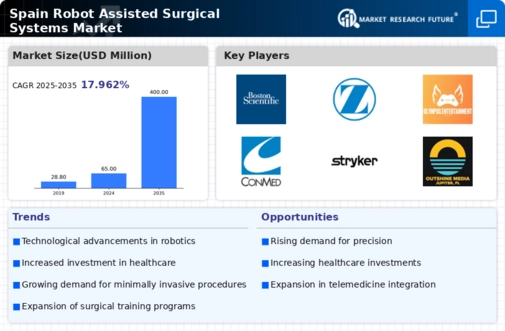Investment in Healthcare Infrastructure
The Spanish government is actively investing in healthcare infrastructure, which is a significant driver for the robot assisted-surgical-systems market. Recent initiatives have focused on modernizing hospitals and integrating advanced technologies to improve patient care. For instance, the Spanish Ministry of Health has allocated approximately €1 billion for the enhancement of surgical facilities across the country. This investment is likely to facilitate the adoption of robotic surgical systems, as hospitals seek to upgrade their capabilities. Enhanced infrastructure not only supports the implementation of these systems but also encourages training and development, further solidifying the market's growth.
Aging Population and Rising Chronic Diseases
Spain's demographic shift towards an aging population is significantly impacting the robot assisted-surgical-systems market. With an increasing number of elderly individuals, there is a corresponding rise in chronic diseases that require surgical intervention. The World Health Organization estimates that by 2030, over 25% of Spain's population will be over 65 years old, leading to a higher demand for surgical procedures. Robot-assisted surgeries, known for their precision and reduced recovery times, are becoming essential in managing these health challenges. This demographic trend suggests a sustained growth trajectory for the market as healthcare systems adapt to the needs of an older population.
Technological Innovations and Product Development
Continuous technological innovations are propelling the robot assisted-surgical-systems market forward. Companies in Spain are investing heavily in research and development to create more advanced robotic systems that offer enhanced functionalities. Recent advancements include improved imaging systems, artificial intelligence integration, and user-friendly interfaces that facilitate surgical procedures. The market is witnessing the introduction of next-generation robotic systems that are not only more efficient but also more cost-effective. This trend suggests a competitive landscape where innovation is key, potentially leading to increased market share for companies that can deliver cutting-edge solutions.
Rising Awareness and Acceptance of Robotic Surgery
There is a growing awareness and acceptance of robotic surgery among both healthcare professionals and patients in Spain. Educational campaigns and successful case studies have contributed to a more informed public, leading to increased demand for robot-assisted procedures. Surveys indicate that approximately 70% of patients are willing to consider robotic surgery when informed about its benefits. This shift in perception is crucial for the robot assisted-surgical-systems market, as it encourages healthcare providers to invest in robotic technologies. As acceptance continues to rise, the market is poised for expansion, driven by both patient choice and physician endorsement.
Increasing Demand for Minimally Invasive Procedures
The rising preference for minimally invasive surgical techniques is a key driver in the robot assisted-surgical-systems market. Patients in Spain are increasingly opting for surgeries that promise reduced recovery times, less postoperative pain, and minimal scarring. This trend is supported by advancements in robotic technology, which enhances precision and control during procedures. According to recent data, minimally invasive surgeries account for approximately 60% of all surgical procedures in Spain, indicating a robust market for robotic systems that facilitate these techniques. As healthcare providers strive to meet patient expectations, the demand for robot-assisted surgeries is likely to grow, further propelling the market forward.



















Leave a Comment